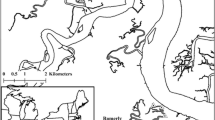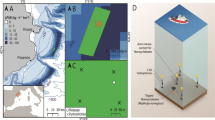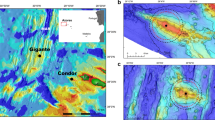Abstract
Cubomedusae are considered to have superior swimming abilities compared to other pelagic cnidarians, yet many of the theories describing such behaviours are based on anecdotal evidence, sting records or opportunistic sightings, rather than quantitative data. Acoustic telemetry was used to document the movements of adult Chironex fleckeri medusae within both coastal and estuarine habitats. The rate at which tagged medusae moved was influenced by an interaction between time period (day or night) and habitat (coastal or estuarine), with rates of travel being relatively similar during the day and night within the coastal habitat, but significantly greater at night than during the day within the estuarine habitat. Medusae in coastal habitats travelled at similar rates throughout all tidal states while estuarine medusae travelled at significantly faster rates towards the middle of the tide than at the low and high ebbs. Such movements occurred with, and independent of, tidally generated currents, but at increased current speeds, medusae tended to travel with the current. Data are also presented that show that large medusae may move from coastal to estuarine habitats.







Similar content being viewed by others
References
Atkinson, L. J., S. Mayfield & A. C. Cockcroft, 2005. The potential for using acoustic tracking to monitor the movement of the West Coast rock lobster Jasus lalandii. African Journal of Marine Science 27: 401–408.
Barnes, J. H., 1960. Observations on jellyfish stings in north Queensland. Medical Journal of Australia 2: 993–999.
Barnes, J. H., 1965. Chironex fleckeri and Chiropsalmus quadrigatus: morphological distinctions. North Queensland Naturalist 32: 13–22.
Barnes, J. H., 1966. Studies on three venomous Cubomedusae. In The Cnidaria and Their Evolution: Symposium of the Zoological Society of London. No. 16 Academic Press, London: 307–332.
Blaber, S. J. M. & T. G. Blaber, 1980. Factors affecting the distribution of juvenile estuarine and inshore fish. Journal of Fish Biology 17: 143–162.
Blaber, S. J. M., D. T. Brewer & J. P. Salini, 1989. Species composition and biomass of fishes in different habitats or a tropical Northern Australian estuary: their occurrence in the adjoining sea and estuarine dependence. Estuarine. Coastal and Shelf Science 29: 509–531.
Blaber, S. J. M., D. T. Brewer & J. P. Salini, 1995. Fish communities and the nursery role of the shallow inshore waters of a tropical bay in the Gulf of Carpentaria, Australia. Estuarine, Coastal and Shelf Science 40: 177–193.
Brown, T., 1973. Chironex fleckeri – Distribution and Movements Around Magnetic Island, North Queensland. World Life Research Institute, Colton, California. ISBN 095994365X.
Cyrus, D. P. & S. J. M. Blaber, 1992. Turbidity and salinity in a Tropical Northern Australian Estuary and their influence on fish distribution. Estuarine, Coastal and Shelf Science 35: 545–563.
Egli, D. P. & R. C. Babcock, 2004. Ultrasonic tracking reveals multiple behavioural modes of snapper (Pagrus auratus) in a temperate no-take marine reserve. Journal of Marine Science 61: 1137–1143.
Gordon, M. R., 1998. Ecophysiology of the Tropical Australian Chirodropid Chiropsalmus sp. Honours Thesis, School of Tropical and Marine Biology, James Cook University of North Queensland, Australia.
Gordon, M. R., C. Hatcher & J. E. Seymour, 2004. Growth and age determination of the tropical Australian cubozoan Chiropsalmus sp. Hydrobiologia 530/531: 339–345.
Hamner, W. M. & D. Doubilet, 1994. Australian box jellyfish–a killer down under. National Geographic 186: 116–130.
Hamner, W. M., M. S. Jones & P. P. Hamner, 1995. Swimming, feeding, circulation and vision in the Australian box jellyfish, Chironex fleckeri. Marine and Freshwater Research 46: 985–990.
Hartwick, R. F., 1987. The box jellyfish. In Covachevich, J., P. Davie & J. Pearn (eds), Toxic Plants and Animals–A Guide for Australia. Queensland Museum Press, Brisbane: 99–105.
Hartwick, R. F., 1991. Distributional ecology and behaviour of the early life stages of the box-jellyfish Chironex fleckeri. Hydrobiologia 216/217: 181–188.
Heupel, M. R. & C. A. Simpfendorfer, 2005. Quantitative analysis of aggregation behaviour in juvenile black tip sharks. Marine Biology 147: 1239–1249.
Heupel, M. R., J. M. Semmens & A. J. Hobday, 2006. Automated acoustic tracking of aquatic animals: scales, design and deployment of listening station arrays. Marine and Freshwater Research 57: 1–13.
Jackson, G. D., R. K. O’Dor & Y. Andrade, 2005. First tests of hybrid acoustic/archival tags on squid and cuttlefish. Marine and Freshwater Research 56: 425–430.
Kerwath, S. E., A. Gotz, P. D. Cowley, W. H. H. Sauer & C. Attwood, 2005. A telemetry experiment on spotted grunter Pomadasys commersonnii in an African estuary. African Journal of Marine Science 27: 389–394.
Kinsey, B. E., 1986. Barnes on Box Jellyfish. James Cook University of North Queensland (Sir George Fisher Centre for Tropical Marine Studies), Townsville, Australia. ISBN 0864432003.
Marsh, L. M., S. M. Slack-Smith & D. L. Gurry, 1986. Sea Stingers – and other venomous and poisonous marine invertebrates of Western Australia. Western Australia Museum, Perth, Australia.
Omundsen, S. L., M. J. Sheaves & B. W. Molony, 2000. Temporal population dynamics of the swarming shrimp, Acetes sibogae australis, in a tropical near-shore system. Marine and Freshwater Research 51: 249–254.
Rifkin, J., 1996. Jellyfish mechanisms. In Williamson, J. J., P. J. Fenner, J. W. Burnett & J. Rifkin (eds), Venomous and Poisonous Marine Animals – A Medical and Biological Handbook. University of New South Wales, Sydney, Australia: 121–173.
Robertson, A. I. & N. C. Duke, 1987. Mangroves as nursery sites: comparisons of the abundance and species composition of fish and crustaceans in mangroves and other nearshore habitats in tropical Australia. Marine Biology 96: 193–205.
Robertson, A. I. & N. C. Duke, 1990. Recruitment, growth and residence time of fishes in a tropical Australian mangrove system. Estuarine, Coastal and Shelf Science 31: 723–743.
Seymour, J. E., T. J. Carrette & P. A. Sutherland, 2004. Do box jellyfish sleep at night? Medical Journal of Australia 181: 706.
Shorten, M., J. Davenport, J. E. Seymour, M. C. Cross, T. J. Carrette, G. Woodward & T. F. Cross, 2005. Kinematic analysis of swimming in Australian box jellyfish, Chiropsalmus sp. and Chironex fleckeri (Cubozoa, Cnidaria: Chirodropidae). Journal of Zoology 267: 371–380.
Southcott, R. V., 1956. Studies on Australian Cubomedusae, including a new genus apparently harmful to man. Australian Journal of Marine and Freshwater Ecology 7: 254–280.
Southcott, R. V., 1971. The box-jellies or sea-wasps. Australian Natural History 17: 123–128.
Staples, D. J. & D. J. Vance, 1987. Comparative recruitments of the banana prawn, Penaeus merguiensis, in five estuaries of South-eastern Gulf of Carpentaria, Australia. Australian Journal of Marine and Freshwater Research 38: 29–45.
Vance, D. J. & D. J. Staples, 1992. Catchability and sampling of three species of juvenile penaeid prawns in the Embley River, Gulf of Carpentaria, Australia. Marine Ecology Progress Series 87: 210–213.
Vance, D. J., D. S. Heales & N. R. Loneragan, 1994. Seasonal, diel and tidal variation in beam-trawl catches of juvenile grooved tiger prawns, Penaeus semisulcatus (Decapoda: Penaeidae), in the Embley River, North-eastern Gulf of Carpentaria, Australia. Australian Journal of Marine and Freshwater Research 45: 35–42.
Vance, D. J., M. D. E. Haywood, D. S. Heales, R. A. Kenyon, N. R. Loneragan & P. C. Pendrey, 1996. How far do prawns and fish move into mangroves? Distribution of juvenile banana prawns Penaeus merguiensis and fish in a tropical mangrove forest in northern Australia. Marine Ecology Progress Series 131: 115–124.
Willis, J. & A. J. Hobday, 2007. Influence of upwelling on movement of southern bluefin tuna (Thunnus maccoyii) in the Great Australian Bight. Marine and Freshwater Research 58: 699–708.
Wingate, R. L. & D. H. Secor, 2007. Intercept telemetry of the Hudson River Striped Bass resident contingent: migration and homing patterns. Transactions on the American Fisheries Society 136: 95–104.
Xiao, Y. & J. G. Greenwood, 1992. Distribution and behaviour of Acetes sibogae Hansen (Decapoda, Crustacea) in an estuary in relation to tidal and diel environmental changes. Journal of Plankton Research 14: 393–407.
Xiao, Y. & J. G. Greenwood, 1993. The biology of Acetes (Crustacea; Sergestidae). Oceanography and Marine Biology: An Annual Review 31: 259–444.
Yamaguchi, M., 1982. Cubozoans and their life histories. Aquabiology Tokyo 4: 248–254.
Yamaguchi, M., 1985. Occurrence of the Cubozoan medusae Chiropsalmus quadrigatus in the Ryukyus. Bulletin on Marine Science 37: 780–781.
Acknowledgements
This research would not have been possible without financial support from the Lions Foundation of Australia, National Geographic, Mission Beach Tourism Commission, Australian Geographic, Cairns City Council, Cardwell Shire Council, Smart State Queensland, Weipa Houseboats and Comalco. Sincere thanks to Teresa Carrette, Robert Gordon, Anna Kintner, Glenda, Amelia and Benjamin Seymour and Ben Kelly for their assistance in fieldwork.
Author information
Authors and Affiliations
Corresponding author
Additional information
Guest editors: K. A. Pitt & J. E. Purcell
Jellyfish Blooms: Causes, Consequences, and Recent Advances
Rights and permissions
About this article
Cite this article
Gordon, M.R., Seymour, J.E. Quantifying movement of the tropical Australian cubozoan Chironex fleckeri using acoustic telemetry. Hydrobiologia 616, 87–97 (2009). https://doi.org/10.1007/s10750-008-9594-7
Published:
Issue Date:
DOI: https://doi.org/10.1007/s10750-008-9594-7




